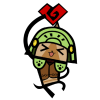Sorry. I don't quite understand the tree. Do all of the classes inherit from Map? And is there a class Type that inherits from Item? I think what you mean is that class Type has a script as an attribute, Item has a type as an attribute, and that a Map has a group of moving objects, again as an attribute.
The general idea of class inheritance is that classes that inherit from another class have similar functionalities and attributes with the class they inherit from. Class inheritance is an IS-A relationship, like an Enemy is a Character, and a Character is a MovingObject. An attribute is a HAS-A relationship, like an Item has a Type, and a Type has a Script.
Like Alberth suggested, I think you need to start with something simpler first. Make the map first, make sure it renders the tiles well. Then give a player that moves in it. You'll gain more understanding as you go, and you can develop it further once you get the hang of things.








